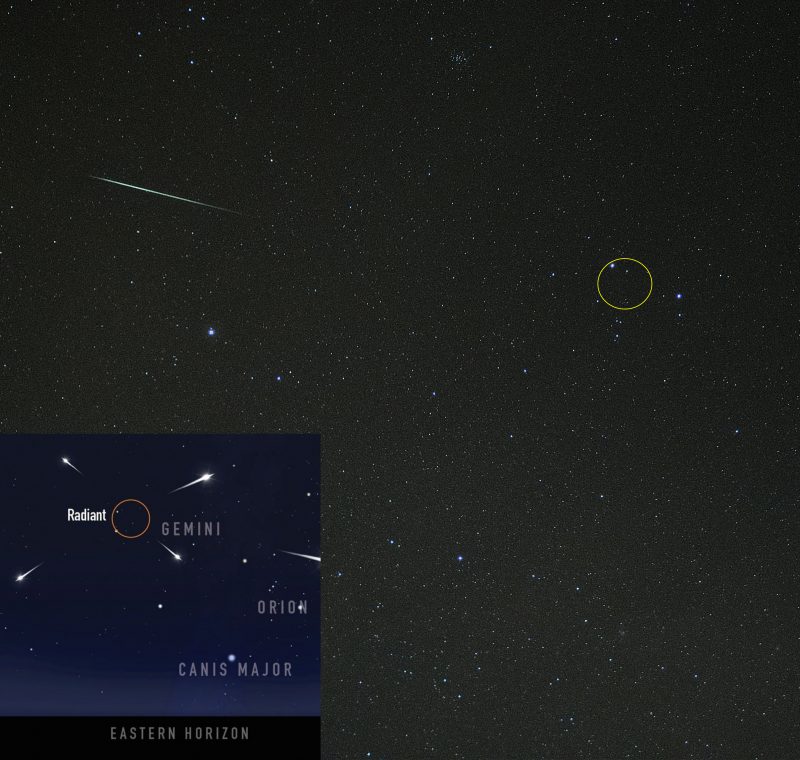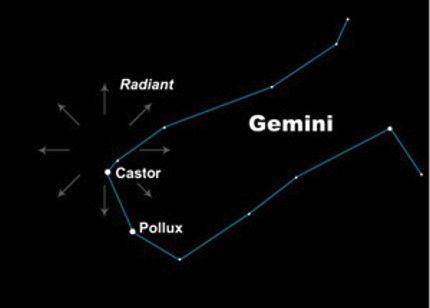
The annual Geminid meteor shower is expected to reach its peak this weekend – though under the glaring light of the almost-full waning gibbous moon. The peak morning is likely to be Saturday, December 14, 2019 – or, possibly, Sunday, December 15, 2019. But the morning of December 13 might offer some meteors, too. These colorful meteors tend to be bright, so you might see as many as 20 or so Perseids per hour, despite the moonlight. On a dark night, free of moonlight, you can easily spot 50 or more meteors per hour.
Just know that – although this is one shower you can successfully watch in the (late) evening – the best viewing is typically around 2 a.m., no matter where you are on Earth.
Want to see 2018’s brightest comet? How to see comet 46P/Wirtanen

Veteran meteor photographer Eliot Herman in Tucson, Arizona, captured this Geminid meteor flying from the radiant point on December 8, 2018. Note that the inset is our radiant point chart, shown at the top of this post. Thanks, Eliot!

The Geminids radiate from near bright Castor in the constellation Gemini, in the east on December evenings. Read more.
So the best time of night to watch for Geminid meteors is around 2 a.m., when the the shower’s radiant point – near the bright star Castor in the constellation Gemini – is high in the sky.
If you’re not one to stay up late, you can watch for meteors during the evening hours. Although the meteors will be few and far between at early-to-mid evening, you might, if you’re lucky, catch an earthgrazer – a sloow-moving and loong-lasting meteor that travels horizontally across the sky.
Can you watch the meteor shower online? Yes. It won’t be the same experience as being out under a dark country sky. But, especially if you’re clouded out and can’t get out of the city, watching online can be a good way to join the fun. So far, we’ve heard from only one organization planning to broadcast the Geminids live. It’s sky-live.tv, which will cover the live event with 3 cameras in Teide Observatory (Canary Islands), Olivenza (Extremadura) and High Energy Observatory HESS (Namibia).
The narration will be in Spanish. Find the live broadcast here: https://www.youtube.com/embed/LHuT5yDtDu0.
English speakers might like sky-live.tv’s Sky Cam for the Geminids, which has no narration: https://www.youtube.com/embed/mFUBpGEjY54.
Can you watch from the Southern Hemisphere? Sure! At temperate latitudes in the Southern Hemisphere, the meteors tend to be fewer. The Geminids do favor the Northern Hemisphere, where the radiant appears higher in the sky. However, this shower is also visible from the tropical and subtropical parts of the Southern Hemisphere.
How many meteors will you see? The Geminids are a consistent and prolific shower, but the numbers of meteors you see also strongly depends on your sky conditions and on how far you are from city lights. Often, in the hours after midnight and under a dark sky, you can see 50 or more meteors per hour. Rates of 120 per hour have been reported at the peak, under optimum sky conditions.
In 2019, moonlight will obtrude on this year’s production. How many will you see? Hard to say for sure! Just watch, and let us know.
Remember … meteors in annual showers typically come in spurts and lulls, so give yourself at least an hour of observing time. Simply sprawl out on a reclining lawn chair, look upward and enjoy the show.
Where do the meteors come from? Although meteors are sometimes called “shooting stars,” they have nothing to do with stars. Instead, they are strictly a solar system phenomenon. Around this time every year, our planet Earth crosses the orbital path of a mysterious object called 3200 Phaethon, which might be an asteroid or a burnt-out comet orbiting our sun.

Orbital path of 3200 Phaethon, the parent object of the Geminid meteors, via skyandtelescope.com
Debris from this object burns up in the Earth’s upper atmosphere to give us the annual Geminid meteor shower. Read more about 3200 Phaethon, the Geminid’s parent object.
EarthSky lunar calendars are cool! They make great gifts. Order now. Going fast!

John Ashley in Glacier National Park, Montana, caught this amazing earthgrazer meteor on December 6, 2018. Earthgrazers are best seen in the evening hours. Watch for them during this week’s Geminid meteor shower! John said this one lasted approximately 4 seconds and left behind a glowing smoke train that lasted at least 24 minutes. He commented: “The meteor went dark just above Dusty Star Mountain, or ‘Iszika-kakatosi’ in Blackfeet, which translates to ‘smoking star.'” Cool! Thanks, John! Nikon D750, Rokinon 24mm lens @ f1.4, 30 sec, ISO 3200.
Bottom line: With the moon out nearly all night long, this year’s Geminid meteor shower will be marred by moonlight. Peak morning is probably December 14, but watch December 13 and 15, too. You might catch some bright Geminids overcoming the moonlit glare!
Read more: 10 tips for watching the Geminids
Read more: Find the Geminid meteors’ radiant point
Read more: All you need to know about the Geminid meteor shower
from EarthSky https://ift.tt/2QIqicy

The annual Geminid meteor shower is expected to reach its peak this weekend – though under the glaring light of the almost-full waning gibbous moon. The peak morning is likely to be Saturday, December 14, 2019 – or, possibly, Sunday, December 15, 2019. But the morning of December 13 might offer some meteors, too. These colorful meteors tend to be bright, so you might see as many as 20 or so Perseids per hour, despite the moonlight. On a dark night, free of moonlight, you can easily spot 50 or more meteors per hour.
Just know that – although this is one shower you can successfully watch in the (late) evening – the best viewing is typically around 2 a.m., no matter where you are on Earth.
Want to see 2018’s brightest comet? How to see comet 46P/Wirtanen

Veteran meteor photographer Eliot Herman in Tucson, Arizona, captured this Geminid meteor flying from the radiant point on December 8, 2018. Note that the inset is our radiant point chart, shown at the top of this post. Thanks, Eliot!

The Geminids radiate from near bright Castor in the constellation Gemini, in the east on December evenings. Read more.
So the best time of night to watch for Geminid meteors is around 2 a.m., when the the shower’s radiant point – near the bright star Castor in the constellation Gemini – is high in the sky.
If you’re not one to stay up late, you can watch for meteors during the evening hours. Although the meteors will be few and far between at early-to-mid evening, you might, if you’re lucky, catch an earthgrazer – a sloow-moving and loong-lasting meteor that travels horizontally across the sky.
Can you watch the meteor shower online? Yes. It won’t be the same experience as being out under a dark country sky. But, especially if you’re clouded out and can’t get out of the city, watching online can be a good way to join the fun. So far, we’ve heard from only one organization planning to broadcast the Geminids live. It’s sky-live.tv, which will cover the live event with 3 cameras in Teide Observatory (Canary Islands), Olivenza (Extremadura) and High Energy Observatory HESS (Namibia).
The narration will be in Spanish. Find the live broadcast here: https://www.youtube.com/embed/LHuT5yDtDu0.
English speakers might like sky-live.tv’s Sky Cam for the Geminids, which has no narration: https://www.youtube.com/embed/mFUBpGEjY54.
Can you watch from the Southern Hemisphere? Sure! At temperate latitudes in the Southern Hemisphere, the meteors tend to be fewer. The Geminids do favor the Northern Hemisphere, where the radiant appears higher in the sky. However, this shower is also visible from the tropical and subtropical parts of the Southern Hemisphere.
How many meteors will you see? The Geminids are a consistent and prolific shower, but the numbers of meteors you see also strongly depends on your sky conditions and on how far you are from city lights. Often, in the hours after midnight and under a dark sky, you can see 50 or more meteors per hour. Rates of 120 per hour have been reported at the peak, under optimum sky conditions.
In 2019, moonlight will obtrude on this year’s production. How many will you see? Hard to say for sure! Just watch, and let us know.
Remember … meteors in annual showers typically come in spurts and lulls, so give yourself at least an hour of observing time. Simply sprawl out on a reclining lawn chair, look upward and enjoy the show.
Where do the meteors come from? Although meteors are sometimes called “shooting stars,” they have nothing to do with stars. Instead, they are strictly a solar system phenomenon. Around this time every year, our planet Earth crosses the orbital path of a mysterious object called 3200 Phaethon, which might be an asteroid or a burnt-out comet orbiting our sun.

Orbital path of 3200 Phaethon, the parent object of the Geminid meteors, via skyandtelescope.com
Debris from this object burns up in the Earth’s upper atmosphere to give us the annual Geminid meteor shower. Read more about 3200 Phaethon, the Geminid’s parent object.
EarthSky lunar calendars are cool! They make great gifts. Order now. Going fast!

John Ashley in Glacier National Park, Montana, caught this amazing earthgrazer meteor on December 6, 2018. Earthgrazers are best seen in the evening hours. Watch for them during this week’s Geminid meteor shower! John said this one lasted approximately 4 seconds and left behind a glowing smoke train that lasted at least 24 minutes. He commented: “The meteor went dark just above Dusty Star Mountain, or ‘Iszika-kakatosi’ in Blackfeet, which translates to ‘smoking star.'” Cool! Thanks, John! Nikon D750, Rokinon 24mm lens @ f1.4, 30 sec, ISO 3200.
Bottom line: With the moon out nearly all night long, this year’s Geminid meteor shower will be marred by moonlight. Peak morning is probably December 14, but watch December 13 and 15, too. You might catch some bright Geminids overcoming the moonlit glare!
Read more: 10 tips for watching the Geminids
Read more: Find the Geminid meteors’ radiant point
Read more: All you need to know about the Geminid meteor shower
from EarthSky https://ift.tt/2QIqicy

Aucun commentaire:
Enregistrer un commentaire